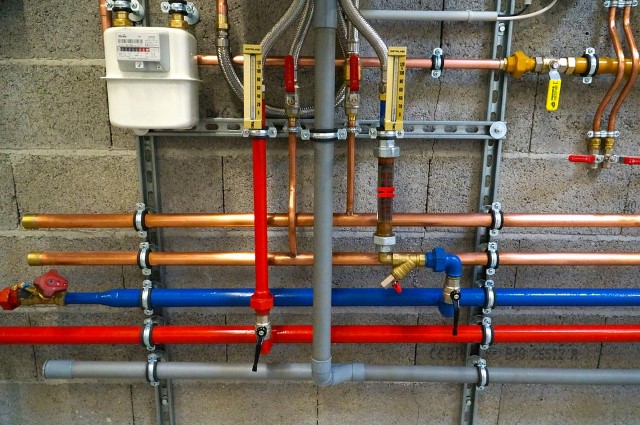As a plumber, one of the most common questions I get from homeowners is about pipe materials: which one is best, what works for repairs, and what should they consider when building or remodeling. The truth is, there’s no one-size-fits-all answer. The type of pipe material you need depends on your home’s age, water quality, and specific plumbing needs. Let me break it down for you.
The Most Common Types of Pipe Materials for Homes
Over the years, plumbing has evolved significantly, bringing a variety of pipe materials into use. Here are the main types you’ll encounter in modern homes—and even some older ones.
1. Copper Pipes
Copper has been the gold standard for plumbing for decades, and for good reason.
- Durability: Copper pipes can last 50+ years with proper care.
- Resistance to Corrosion: They don’t degrade easily, even with regular water exposure.
- Safe Drinking Water: Copper doesn’t leach harmful chemicals into your water.
- Drawbacks: Copper is one of the more expensive options, and its installation requires soldering, which may not be DIY-friendly.
2. PEX Pipes (Cross-Linked Polyethylene)
PEX is a newer option that’s quickly becoming a favorite in residential plumbing.
- Flexibility: PEX can bend around corners, reducing the need for fittings and speeding up installation.
- Affordability: It’s less expensive than copper and easier to install, saving on labor costs.
- Resistance to Freezing: PEX can expand slightly, making it less likely to burst in freezing temperatures.
- Drawbacks: PEX isn’t suitable for outdoor use, as UV rays can degrade the material.
3. PVC Pipes (Polyvinyl Chloride)
PVC pipes are commonly used for drainage, vent lines, and some cold-water applications.
- Lightweight and Easy to Work With: This makes PVC a great choice for DIY projects.
- Inexpensive: It’s one of the most budget-friendly options available.
- Drawbacks: PVC isn’t suitable for hot water applications, as it can warp under high temperatures. Additionally, it’s not as durable as other materials for long-term use.
4. CPVC Pipes (Chlorinated Polyvinyl Chloride)
CPVC is similar to PVC but treated to withstand higher temperatures.
- Hot and Cold Water Use: CPVC is suitable for both, making it more versatile than standard PVC.
- Corrosion Resistance: It’s a good option in areas with corrosive water supplies.
- Drawbacks: Like PVC, it’s not as durable as metal pipes and can become brittle over time.
5. Galvanized Steel Pipes
If you live in an older home, you might have galvanized steel pipes. These were popular from the 1930s to the 1980s.
- Strength: Galvanized pipes are durable and resistant to physical damage.
- Drawbacks: Over time, they corrode on the inside, leading to reduced water flow and potential contamination. If your home still has galvanized pipes, it’s often worth replacing them.
6. Cast Iron Pipes
Cast iron is another material found in older homes, often used for drainage systems.
- Durability: Cast iron pipes can last for decades and are incredibly strong.
- Soundproofing: They dampen the noise of water flow better than most materials.
- Drawbacks: Cast iron is prone to rusting and can be very heavy, making repairs and replacements more challenging.
7. Stainless Steel Pipes
Stainless steel pipes are less common but sometimes used in specific applications.
- Corrosion Resistance: Stainless steel is highly resistant to rust and corrosion.
- Drawbacks: It’s more expensive than many other materials, and often, other options (like copper or PEX) can achieve the same results at a lower cost.
How to Choose the Right Pipe Material for Your Home
Here are some factors to consider when deciding on pipe material:
- Your Budget:
Copper and stainless steel are premium options, while PEX and PVC offer budget-friendly alternatives. - Water Quality:
If your water is highly acidic, consider materials like CPVC or PEX that resist corrosion. - Application:
- For hot water lines, use copper, CPVC, or PEX.
- For outdoor plumbing, stick with metal pipes like copper or galvanized steel.
- Local Building Codes:
Always check local codes to ensure compliance with material requirements in your area. - Longevity and Maintenance:
Consider how long the material will last and what maintenance it may require over time.
Tips for Homeowners
- Know Your System: Take the time to understand what pipe materials your home currently has. A simple inspection or consultation with a plumber can help.
- Plan for Upgrades: If your home has older materials like galvanized steel or cast iron, start budgeting for replacements before issues arise.
- Invest in Quality: While cheaper materials may seem appealing upfront, they can lead to costly repairs or replacements down the line.
- Hire a Professional: Plumbing isn’t always a DIY-friendly field. A licensed plumber can ensure proper installation and compliance with local codes.
Final Thoughts
The type of pipes you choose plays a critical role in the efficiency and safety of your home’s plumbing system. As a plumber, I’ve worked with all these materials and can confidently say that the best choice depends on your specific needs and budget. Whether you’re building, remodeling, or troubleshooting an existing system, understanding your options is the first step to a hassle-free plumbing system. If you have questions about your home’s plumbing, don’t hesitate to reach out—I’m here to help!


Recent Comments